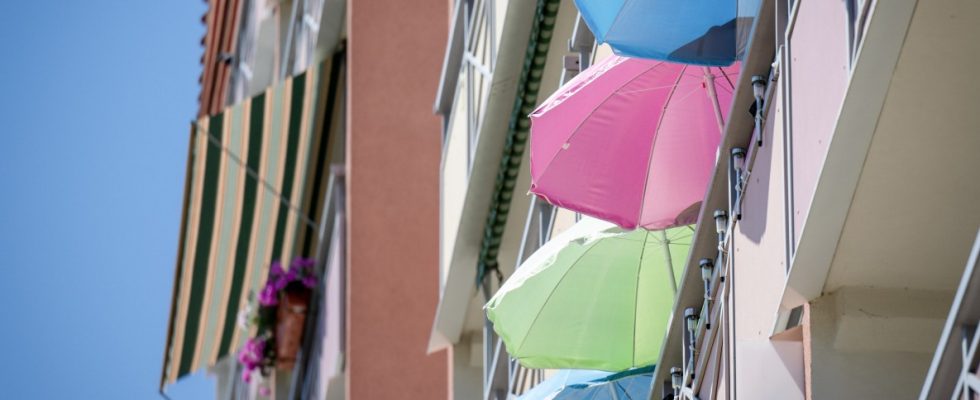Extreme weather becomes normal. The German Weather Service has observed that heat waves have recently increased in frequency and intensity. Temperatures over 30 degrees in this country and blazing heat of 40 degrees in the Mediterranean are no longer uncommon. In addition, there are dramatic changes in the weather with storms and heavy rain. In some places, as much water rushes from the sky in one hour as would otherwise be the case over a month.
The heat builds up particularly in the inner cities with their sealed areas, dense buildings and deep street canyons. At night, stone, concrete and asphalt release the heat stored during the day into the environment, preventing the air from cooling down. The increasingly frequent heavy rain is overwhelming the sewage system, which is not designed to handle such volumes of water in a short period of time. The result: full cellars, flooded streets and damage to the building structure.
“We would actually have to react very quickly now,” says Martina Winker, an expert on water infrastructure at the Institute for Social-Ecological Research ISOE. But adapting the pipes and collection systems of the city sewer system, the sewage treatment plants and the water supply would mean enormous construction work over the years. “We don’t have that time,” emphasizes Winker. That’s why, at the same time, a move has been made to no longer just channeling and draining rainwater under the heading “sponge city”, but rather storing it locally and making it usable on site – through unsealing, green roofs, and infiltration troughs. What has so far received little attention is the sponge potential of facades. And that is huge.
One element stores around 8,100 liters of water
Researchers at the Fraunhofer Institute for Environmental, Safety and Energy Technology (UMSICHT) have calculated that 4,200 liters of water rain down on the roof of a typical inner-city apartment block of 420 square meters within 15 minutes of heavy rain. Water that often flows unused through the roof drainage and, in the worst case, causes the sewer system to overflow. “We would like to store the rainwater that occurs on the building directly on the building and use it profitably,” says Holger Wack, deputy department head for product development at the institute. A team is developing a new type of storage element, the “Vertical Water Sponge”.
This vertical sponge consists of modules with a load-bearing, permeable shell, for example made of perforated sheet metal, and a water-storing filling made of mineral materials. Ideally, shredded materials from recycling processes such as bricks, sand-lime bricks, aerated concrete, which have very good water storage capacities, are used for the filling. The modules are placed one on top of the other, mounted on the facade and connected to the roof drainage.
According to the development team, such a sponge element with a width of one and a half meters and a depth of 50 centimeters with an eaves height of the building of almost eleven meters stores around 8,100 liters of water – depending on the filling material. “This means we can also absorb long-lasting precipitation or heavy rain events that occur several times in a row, especially since it is possible to mount several elements on a façade,” explains Holger Wack. “So we can quickly remove large amounts of water from the system.”
The water should not only be stored, but also contribute to improving the microclimate in the immediate area through evaporation – hence the perforated sheet metal. Not least due to the large surface area of the shredded filling materials, Fraunhofer UMSICHT expects a cooling effect over several days.
Many experts believe that increasing reliance on evaporation makes sense, and not just in view of future heat waves, says water infrastructure expert Martina Winker, who is not involved in the project. “Colleagues have determined that a strong focus on infiltration alone is not enough. Our cities need more evaporation to support the water cycle.”
When planting a facade there is a risk that the plants will dry out
Green facades can also store and evaporate water. However, it must always have a certain level of moisture so that the plants do not dry out. In addition, the amount of precipitation would have to be temporarily stored and gradually released to the plants. This is complex and there is usually not enough space for storage tanks in inner-city areas. The vertical water storage takes up comparatively little space. It is intended to be used in both new buildings and existing buildings. “We are thinking about residential or commercial buildings up to ten floors high,” says Holger Wack.
Martina Winker sees particular potential in the use of private urban areas for the storage and evaporation of rainwater. “The city authorities can only plan on public areas, and these are limited. So we have to get the property owners and building owners on board.” There would be incentives because most cities have a split wastewater fee. This means that you have to pay extra for drained rainwater. Anyone who retains precipitation on their property will be rewarded.
The vertical sponge is still in the development phase. After investigations with various mineral substrates, a first demonstrator is now being created on the Fraunhofer UMSICHT site in Oberhausen. The research team would like to test the performance of the concept under real site and weather conditions.
“We will have to deal with large amounts of precipitation differently in the future,” sums up Martina Winker. The question is: “What do we want to achieve?” Should urban greenery be irrigated with rainwater? Is this intended to replenish the groundwater body? Or should rainwater help cool urban heat islands through evaporation? For all of these goals, there is no one technology that makes sense everywhere, says Winker. “We need a toolbox full of different measures that we use depending on the situation.”

